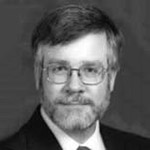Steve Hardin
 Brief Career Biography
Brief Career Biography
I started life after graduating from college in 1976 as a broadcast journalist, working mostly in radio. I decided to become a librarian because it’s a lot like reporting, actually – you just use books and online sources instead of interviewing people. After I got my MSLIS from the University of Illinois in 1989, I began working at Indiana State University and I’ve been here ever since. I started out as half-time “electronic information services” (back in the pre-web days) and half-time cataloging. Over the years my job has evolved a lot. I’ve acted as a department chair for several departments and currently serve as the library’s liaison to the university’s faculty in geography, geology, anthropology, communication, political science, mathematics and computer science. With demand for reference services in decline, I am also spending more time teaching.
Benefits of ASIS&T
The wide variety of disciplines represented. At ASIS&T, you can talk to librarians, computer experts, publishers, database producers, attorneys, information architects, faculty members and members of other disciplines far too numerous to mention. The cross-pollination with other disciplines is really helpful. Talk about networking opportunities! Also, ASIS&T is much more cutting edge in terms of research than many other organizations. Back when I used to attend both ASIS&T and ALA meetings, I found ALA would cover topics ASIS&T had covered two or three years earlier. In addition, I’ve made a lot of lifelong friends at ASIS&T. Its comparatively small size means you could easily find yourself sitting next to a president or a member of the board of directors. Nearly everyone in ASIS&T that I’ve met is pretty unassuming, and eager to discuss new ideas with everyone else. It’s a very, very welcoming space!
Advice for New Information Professionals
- Network, network, network. Meet as many people as you can and remember their names and specialties. Networking has three immediate benefits: a) you have a ready-made list of experts to consult when you need help; b) when the time comes to change jobs, it’s all but essential to know someone on the inside of the company/university at which you want to work; c) having a bunch of friends and acquaintances just makes life more pleasant.
- Explore Quadrant II. Stephen Covey’s The Seven Habits of Highly Effective People classifies Quadrant II tasks as “Important but not urgent,” such as the software package you really should learn, but there’s always something more urgent preventing you from investing the time needed. All of the “seven habits” Covey discusses lie in this quadrant. Quadrant II is where you can really grow as a professional. And try not to get bogged down in Quadrant III traps such as endless committee meetings or ineffective groups that don’t really do anything.
- Flexibility. Every job has parts you like and parts you don’t. You can have more fun if you cultivate an interest in everything. Be flexible enough to take on challenges that don’t fit you exactly (as long as they’re not Quadrant III traps!) You’ll be surprised as you grow in directions you weren’t expecting!
